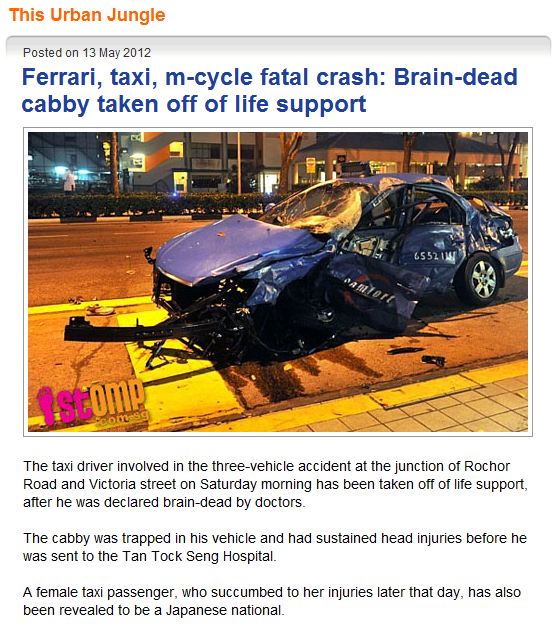On 26 May 2012, Singapore’s attention will be focused on the Hougang constituency by-election between the Workers’ Party’s (WP) Png Eng Huat and the People’s Action Party’s (PAP) Desmond Choo. They are contesting the Hougang constituency because the former Member of Parliament Yaw Shin Leong was expelled by the WP for failing to answer allegations about his extra-marital affairs. He then subsequently fled the country. The by-election will be watched closely, as the WP has held Hougang for over 20 years against the ever dominant PAP machine, but its reputation has taken a hit due to the improprieties of Yaw.
However, in recent days, the spotlight in social media and some parts of the traditional media has focused less on the Hougang by-election and more on a traffic accident that occurred early on the morning of 12 May 2012. A Ferrari, driven by a male PRC national working in the finance industry, crashed into a taxi. The Ferrari driver, the Singaporean taxi driver and a Japanese taxi passenger all died. It turned out that the male PRC national Ferrari driver was an ultra-rich immigrant who owned a penthouse in the upper-middle class area of East Coast, while the Singaporean taxi driver was the sole breadwinner for a family of five. A disturbing video of the accident is available here.
Many commentators on Facebook have highlighted how the traffic accident exposed the most severe fault lines currently in Singaporean society — the rich versus the poor, the $1.8 million dollars limited edition Ferrari versus the humble taxi, and PRC foreigners versus locals. Rightly, many have blamed the PAP government and its extremely liberal immigration policies for generating these extreme economic and social inequalities resulting in gross unhappiness among the local population, and gnawing away at Singapore’s once docile social compact.
Moreover, Singaporeans, both online and offline, are becoming divided over their interpretation of the accident. On the one hand, some Singaporeans decry the fact that the Ferrari driver came from China as everything that is wrong about Singapore’s immigration policy and as justification for their open xenophobia against immigrants from the PRC. On the other hand, other Singaporeans have stood up and spoken out against such xenophobia, arguing that such attitudes betray Singapore’s own immigrant history and is detrimental to social harmony.
For now, local anger against foreigners, particularly from the PRC, has largely remained online. Most Singaporeans are also too busy attempting to make a living to bother about directly confronting their discomforts and displeasures with the immigrant population. But a case can be made that the PAP government’s liberal immigration policies has gradually pushed society towards the edge of some form of violent confrontation. Some say that it is only a matter of time before online anger manifests itself into real action.
As the economic rise of China allows its citizens to exert a greater influence over surrounding East Asian countries, many of these countries are finding it increasingly difficult to contain rising anti-China sentiments. Singapore’s tussle over PRC Chinese immigrants is not unlike those found in Hong Kong and South Korea. Confrontations in the South China Sea also mean that anti-China resentment is strong in Vietnam and the Philippines. It will be interesting to observe how the various governments and societies manage these resentments in the near future.
Update: This related piece on Facebook has received thousands of “likes” and “shares”.
Elvin Ong is studying at Oxford University. To begin exploring these issues in more detail you may want to start here.
 Facebook
Facebook  Twitter
Twitter  Soundcloud
Soundcloud  Youtube
Youtube  Rss
Rss 